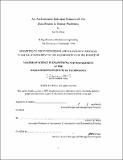An architectural selection framework for data fusion in sensor platforms
Author(s)
Mirza, Atif R
DownloadFull printable version (7.308Mb)
Other Contributors
System Design and Management Program.
Advisor
Olivier de Weck.
Terms of use
Metadata
Show full item recordAbstract
The role of data fusion in sensor platforms is becoming increasingly important in various domains of science, technology and business. Fusion pertains to the merging or integration of information towards an enhanced level of awareness. This thesis provides a canonical overview of several major fusion architectures developed from the remote sensing and defense community. Additionally, it provides an assessment of current sensors and their platforms, the influence of reliability measures, and the connection to fusion applications. We present several types of architecture for managing multi-sensor data fusion, specifically as they relate to the tracking-correlation function and blackboard processing representations in knowledge engineering. Object-Process Methods are used to model the information fusion process and supporting systems. Several mathematical techniques are shown to be useful in the fusion of numerical properties, sensor data updating and the implementation of unique detection probabilities. Finally, we discuss the importance of fusion to the concept and operation of the Semantic Web, which promises new ways to exploit the synergy of multi-sensor data platforms. This requires the synthesis of fusion with ontology models for knowledge representation. We discuss the importance of fusion as a reuse process in ontological engineering, and review key lifecycle models in ontology development. The evolutionary approach to ontology development is considered the most useful and adaptable to the complexities of semantic networks. Several potential applications for data fusion are screened and ranked according to the Joint Directors of Laboratories (JDL) process model for information fusion. Based on these predetermined criteria, the case of medical diagnostic imaging was found to offer the most promising applications for fusion, on which future product platforms can be built.
Description
Thesis (S.M.)--Massachusetts Institute of Technology, System Design and Management Program, February 2007. Includes bibliographical references (leaves 97-100).
Date issued
2007Department
System Design and Management Program.Publisher
Massachusetts Institute of Technology
Keywords
System Design and Management Program.